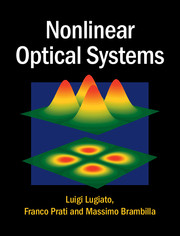Book contents
- Frontmatter
- Dedication
- Contents
- Preface
- Part I Models, propagation, stationary phenomena
- Part II Dynamical Phenomena, Instabilities, Chaos
- 18 Some general aspects in nonlinear dissipative dynamical systems
- 19 Special limits in the single-mode model
- 20 The linear-stability analysis of the Maxwell–Bloch equations
- 21 Adiabatic elimination in the complete Maxwell–Bloch equations
- 22 Dynamical aspects in the laser
- 23 Single-mode and multimode operation in inhomogeneously broadened lasers
- 24 Dynamical aspects in optical bistability
- 25 Self-pulsing in other optical systems
- Part III Transverse optical patterns
- Appendix A The Routh–Hurwitz stability criterion
- Appendix B Calculation of the oscillatory instability boundary
- Appendix C Coefficients of the characteristic equation (20.20)
- Appendix D Derivation of equations (20.27) and (20.28)
- Appendix E Coefficients of equations (20.60) and (20.61)
- Appendix F The exact boundary of the Risken–Nummedal–Graham–Haken instability
- Appendix G Nonlinear analysis of the roll solution
- References
- Index
25 - Self-pulsing in other optical systems
from Part II - Dynamical Phenomena, Instabilities, Chaos
Published online by Cambridge University Press: 05 March 2015
- Frontmatter
- Dedication
- Contents
- Preface
- Part I Models, propagation, stationary phenomena
- Part II Dynamical Phenomena, Instabilities, Chaos
- 18 Some general aspects in nonlinear dissipative dynamical systems
- 19 Special limits in the single-mode model
- 20 The linear-stability analysis of the Maxwell–Bloch equations
- 21 Adiabatic elimination in the complete Maxwell–Bloch equations
- 22 Dynamical aspects in the laser
- 23 Single-mode and multimode operation in inhomogeneously broadened lasers
- 24 Dynamical aspects in optical bistability
- 25 Self-pulsing in other optical systems
- Part III Transverse optical patterns
- Appendix A The Routh–Hurwitz stability criterion
- Appendix B Calculation of the oscillatory instability boundary
- Appendix C Coefficients of the characteristic equation (20.20)
- Appendix D Derivation of equations (20.27) and (20.28)
- Appendix E Coefficients of equations (20.60) and (20.61)
- Appendix F The exact boundary of the Risken–Nummedal–Graham–Haken instability
- Appendix G Nonlinear analysis of the roll solution
- References
- Index
Summary
This chapter concludes the discussion about temporal instabilities and self-oscillations, considering the instabilities that arise in the systems analyzed in Chapter 13, with the exception of optical bistability, which has been discussed separately in Chapter 11.
Section 25.1 focuses on the laser with an injected signal. As already mentioned in Section 13.1, in this system self-pulsing instabilities are rather ubiquitous, and on exploring the parameter space one meets an extremely rich variety of oscillatory behaviors. For example, under extremely high-gain conditions, breathing, spiking and chaos have been identified over various ranges of the driving field strength [294]. In this section we show some results that arise under parametric conditions that are more accessible experimentally. We illustrate especially the coexistence, for the same parametric values, of different oscillatory behaviors that are reached by starting from different initial conditions.
On the other hand, Section 25.2 deals with a laser with a saturable absorber. In this system even the full scenario of stationary intensity solutions in the single-mode model is very complex. For the sake of simplicity, in this section we focus on a simpler rate-equation model that is obtained from the single-mode model of Eqs. (13.13)–(13.17) by adiabatically eliminating the atomic polarization of both active and passive medium. As in Chapter 13, we assume that the atomic transition frequencies are equal and also coincide with a cavity frequency. In this way all the variables in the model can be assumed real, and the linearization around the stationary solution described in Section 13.2 leads to a cubic eigenvalue equation. The spontaneous oscillations which arise from this instability are called repetitive passive Q-switching in the literature.
Section 25.3 considers the stability of the stationary solutions of the degenerate optical parametric oscillator described in Section 13.4 and outlines the scenario of period doubling and chaos that arises under appropriate parametric conditions.
Information
- Type
- Chapter
- Information
- Nonlinear Optical Systems , pp. 306 - 316Publisher: Cambridge University PressPrint publication year: 2015
